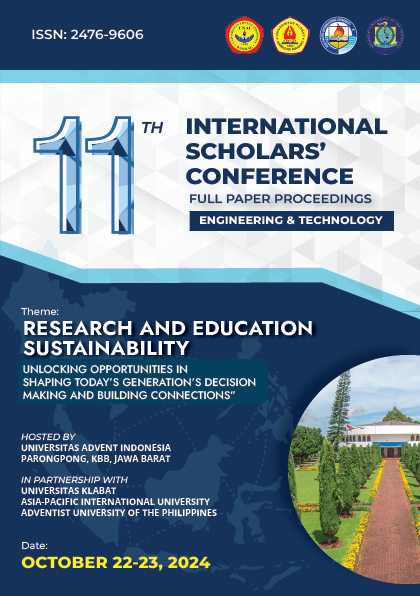Vehicle Parking Area Monitoring and Management System using Computer Vision
Keywords:
vehicle parking, computer vision, OpenCV, yolov8Abstract
The increasing number of vehicles plying thoroughfares requires consequently expanding parking areas in major destinations. In a school setting, where classrooms and academic facilities are an utmost concern, the provision and management of parking areas take a back seat. This study attempts to develop a vehicle parking monitoring and management system to provide convenience and accessibility to stakeholders of a target university in the Philippines. It seeks to optimize the utilization of parking spaces by providing information to vehicle owners on available parking slots, deliver data insights to the school administration for better management and planning, and contribute to the reduction of carbon emissions from cars roaming around looking for an available parking slot. A video camera or a recorded video clip of the parking area can be used as input into the Python programming language paired with OpenCV, a library of computer vision functions. After which, vehicle detection and tracking is performed using YOLOv8. The dedicated web application for management and monitoring is developed using HTML, CSS, and JavaScript complemented by Node.js, Bootstrap, and MongoDB. The study followed the Agile software development lifecycle methodology. The developed system proved to be successful in determining whether specific parking slots are occupied or not, therefore can guide users where to park their vehicles. Illegally parked cars can also be detected by the system. Furthermore, hourly, weekly, and monthly parking data can be generated for better parking management and planning.
Downloads
References
Almeida, P. R. L. de, Oliveira, L. S., Britto, A. S., Silva, E. J., & Koerich, A. L. (2015). PKLot – A robust dataset for parking lot classification. Expert Systems with Applications, 42(11), 4937–4949. https://doi.org/10.1016/j.eswa.2015.02.009
Alsaqqa, S., Sawalha, S., & Abdel-Nabi, H. (2020). Agile software development: Methodologies and trends. International Journal of Interactive Mobile Technologies (iJIM), 14(11), 246–270. https://doi.org/10.3991/ijim.v14i11.13269
An, Q., Wang, H., & Chen, X. (2022). EPSDNET: Efficient campus parking space detection via convolutional neural networks and vehicle image recognition for intelligent Human–Computer interactions. Sensors, 22(24), 9835. https://doi.org/10.3390/s22249835
Bhatt, D., Patel, C., Talsania, H., Patel, J., Vaghela, R., Pandya, S., Modi, K., & Ghayvat, H. (2021). CNN Variants for Computer Vision: History, Architecture, Application, Challenges and Future Scope. Electronics, 10(20), 2470. https://doi.org/10.3390/electronics10202470
CEIC Data (2021). Philippines | Economic indicators, historic data and forecasts | CEIC. Retrieved from https://www.ceicdata.com/en/country/philippines.
Ezarik, M. (2022). Campus parking problems common yet not universal (infographic). Inside Higher Ed | Higher Education News, Events and Jobs. Retrieved from https://www.insidehighered.com/news/2022/12/14/campus-parking-problems-common-yet-not-universal-infographic
Ferol, J. C., Enriquez, C. J. P., Morano, S. M. B., & Nisay, H. F. (2020). Android based smart parking system in preparation to narrowband internet-of–things technology. Linang, 2(1), 43–51. Retrieved from https://www.letranbataan.edu.ph/Files/Research/Linang2019-2020/V1/Article%205.pdf
Hidayat, R., Rushendra, Afiyah, S., Sufyani, R., & Adani, F. (2021). Development of Radio Frequency Identification (RFID) in the Campus Parking System based on Microcontroller. Journal of Physics: Conference Series, 1783(1), 012022. https://doi.org/10.1088/1742-6596/1783/1/012022
IBM. (2021, July 27). What is Computer Vision? | IBM. https://www.ibm.com/topics/computer-vision
Litman, T. A. (2023). Parking Management Strategies, Evaluation and Planning. Victoria Transport Policy Institute. Retrieved from https://www.vtpi.org/park_man.pdf.
Neupane, D., Bhattarai, A., Aryal, S., Bouadjenek, M. R.,
Seok, U., & Seok, J. (2024). Shine: A deep learning-based accessible parking management system. Expert Systems with Applications, 238, 122205. https://doi.org/10.1016/j.eswa.2023.122205
Sharma, A. (2022). Towards the development of a cost-effective Image-Sensing-Smart-Parking Systems (ISenSmaP). Electronic Thesis and Dissertation Repository. 8873. Retrieved from https://ir.lib.uwo.ca/etd/8873
Tambong, A. C. O., Aromin, M. E., Fabian, T. A. M., & Vergara, N. D. P. (2021). LPU PARK’n GO: An android application for realtime parking availability in Lyceum of the Philippines University Cavite. International Journal of Computer Science and Information Technology Research, 9(1), 117–122.
Thakur, N., Bhattacharjee, E., Jain, R., Acharya, B., & Hu, Y.-C. (2023). Deep learning-based parking occupancy detection framework using ResNet and VGG-16. Multimedia Tools and Applications, 83, 1–24. https://doi.org/10.1007/s11042-023-15654-w
Yee, O. C., Yaakob, N., Elshaikh, M., & Azahar, F. (2020). A cloud-based automated parking system for smart campus. IOP Conference Series, 767, 012049. https://doi.org/10.1088/1757-899x/767/1/012049
Downloads
Published
How to Cite
Issue
Section
License
Copyright (c) 2024 11th International Scholars Conference

This work is licensed under a Creative Commons Attribution-ShareAlike 4.0 International License.
Copyright © 2024 ISC Committee.















